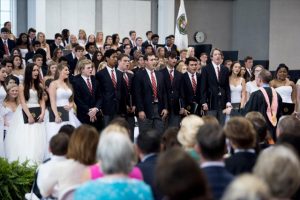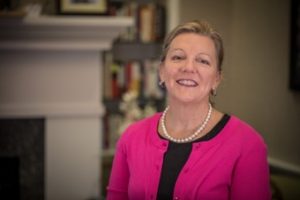The Case for Cultural Competence
By now it’s no secret in the St. Louis community and beyond that MICDS has been in the media spotlight several times over the year, as social media posts and other electronically shared documents became public. While at times it’s tempting to blame social media, it’s important to remember that social media is obviously not the culprit, just as x-rays don’t cause a broken bone.
Social media provides a newly available window—an unfortunately very public and permanent window—into private thoughts and behavior that once took place in secret and left no visible trace. It’s not that racism, homophobia and relational aggression didn’t exist, it’s that evidence was scant, and kids were polite and respectful around adults. These recent social media incidents remind us that we—like the St. Louis community and our nation—have much important work to do as we strive to step up in new ways to help our students develop the understanding, knowledge and skills needed to thrive in the increasingly diverse and global world that awaits them. My goal with this post is to make the case for this energizing and challenging work, and to tell you a bit about how we are going about it.
For decades MICDS—and Country Day and Mary Institute before the merger—has admitted students from across the greater St. Louis area. However, the vast majority of the students in the past were white, affluent and Christian. Bill Polk, our Board Chair, shares that when he graduated from CDS in 1974, all were male and 83% of his class was also both white and Christian.
Thankfully, times have changed, as this photo from our most recent graduating class, the Class of 2017, indicates.

Demographic Changes
Today, students come to our campus from 65 different zip codes each day; 34% of our students self-describe as students of color. International students come to us from five different countries across four continents. 16% of our students speak a language other than English in their homes. Every major world religion is practiced in the homes of our children. And 24% of our students receive the funding needed, as determined by an independent third-party, toward the costs of tuition and basic participation to make attending MICDS possible.
It’s no surprise then, that for most of us, our school community is the most diverse community that we—students, employees or parents—experience.
Our School has changed demographically and for good reason. Certainly St. Louis has changed, and it only makes sense that as a School we actively seek to enroll the strongest applicants, those students who can best benefit from and contribute to the learning environment. Beyond that, the world our students enter will demand sophisticated cross-cultural skills, critical thinking skills, a deeper self-awareness and a better understanding of how others see the world—skills that can only develop through intense interactions with folks whose life experience and perspectives are different than their own. Only within a diverse community of learners can that happen. A diverse learning community benefits allstudents and helps foster the conditions necessary for academic excellence.
But, while necessary, diversity alone is not sufficient.
We must foster an inclusive community, one in which each child and adult feels known, valued, challenged and supported. Our Mission demands this of us: “More than ever our nation needs responsible men and women who can meet the challenges of this world with confidence and embrace all its people with compassion.” To meet the challenges of this world demands sophisticated critical thinking skills and access to the full range of perspectives in order to comprehend these complicated issues and craft novel, multi-lateral, multi-disciplinary solutions.
Our world is changing quickly. Today, there are many cities across the U.S. and five states that are already majority-minority, that is where there are fewer white folks than people of color: my home state of Texas, plus California, Nevada, New Mexico and Hawaii. In fact, sometime shortly after 2040, the entire U.S. will be majority-minority. In addition to working across racial boundaries, students must be able to collaborate effectively with colleagues from around the globe. Those are facts, but how we respond to these changes is a choice.
As members of this evolving local and global community, we can choose to self-isolate, or we can look to this future with great confidence and optimism while preparing ourselves and our children to thrive in this new, vibrant, multicultural community. My goal is to make a case for the latter.
At MICDS, we believe it is in the best interest of each student (and really each of us) to learn to work effectively across the full range of cultural boundaries—across race, religion, national origin, world language—in order to thrive in our communities today and in the years to come.
Cultural Competence: A Critical Skill-Set
This skill set is often called cultural competence, and the fourth objective of the first priority area of our Strategic Plan 2015-2022, developed in partnership with our Board of Trustees and our community, includes the mandate that we focus on fostering this rare skill-set.
Given our own community, we have lots of opportunity to practice cultural competency right here, if we work at it. Colleges and employers across the nation value highly those candidates who demonstrate strong cross-cultural skills and interest in multicultural communities. And they avoid those individuals who are ignorant of cultural dynamics and how they can impact a learning community or workplace.
So pragmatically, if we are preparing kids for higher learning, it is no longer enough to have strong AP scores. To be relevant and thrive, ALL of our students need strong cultural competence skills, both for while they are enrolled here with us, and beyond: at college and in their adult lives.
In addition, we have seen how very damaging it can be both to our community and to the individual students involved when they demonstrate a lack of cultural competence and use language or images in disrespectful ways. Not only have we experienced this firsthand, but we’ve also observed these issues playing out in college admissions. This past June, Harvard rescinded admission offers to 10 students after discovering that the students traded sexually explicit memes that sometimes targeted minority groups in a private Facebook group chat.
Most importantly, each and every child who comes to our campus each day deserves a welcoming, safe, respectful, supportive and challenging learning environment. When students are exposed to remarks or jokes or text messages or images—even out of school—that make them feel other and less than, it is more difficult for them to be fully engaged and perform at their best in school, and their learning can suffer. These micro-aggressions may take many forms, and can exclude and hurt based on race, religion, socio-economic status, legacy status, sexual orientation and national origin, among others.
This is urgent work! We must all step up in big ways to help our students develop cultural competence—critical thinking, empathy, self-knowledge and compassion that comes from collaborating closely and deeply with those whose opinions and life experiences are different from their own. We encompass a diversity of races, cultures and perspectives, and yet, we are here together working and learning side-by-side to accomplish the important work at hand. We must together foster an environment in which students are both respectful and respectfully curious about the points of views of others.
Our Focus This Year: Cultural Competence Work for Adults and Continued Work with Students
Our goal this year is for each of us as adults in the community to also develop greater cultural competence, and strong skills in this area benefit everyone. This focus will allow each of us to be more effective in our work with students to ensure they develop and demonstrate these skills, as well.
Leadership for Equity and Inclusion
I am deeply grateful to Erica Moore for her decade of leadership in diversity and inclusion. As Director of Diversity, Erica worked indefatigably to build strong relationships with many in our community and programming to help students and faculty foster a more inclusive community. In this way, Erica helped us make great strides and put in place and nurtured a number of initiatives. In her new role, Erica is serving as the Director for Faculty Equity and Engagement, and her primary responsibility is to increase the capacity of every adult in our community to foster the conditions for all students to thrive. She continues to work closely with Pathfinders, the African American Support Committee and many student groups. In addition, she is working with all Upper School students as Director of Student Activities, the role Judy Horrell held until her retirement in June. While at first blush it might seem like we are stepping back on our commitment with this change, nothing could be further from the truth, and Erica continues to play a critical leadership role.
We are moving to a more distributed model of leadership in the area of equity and inclusion, and are elevating responsibility for each of us.
With this change, we are doubling down on this effort as we restructure the staffing, and each member of the Administrative Team accepts responsibility to ensure inclusion goals are met within their areas of responsibility. Each educator in our community is making this a priority goal for the year and dedicating time and energy to this work.
Our first challenge is to strengthen each adult’s cultural competence, which in turn will be leveraged in the work each and every one of us does on a daily basis with the students and families and colleagues with whom we interact. And, over the course of the year, we will develop additional strategies and initiatives as we come to understand what our community needs in this area. Next year, we will focus on the research that will give us additional insight into the critical role of relationships, pedagogy and curriculum, to ensure they are responsive to each of the learners in our classrooms, and that we provide windows and mirrors into the experiences of each child.
Thanks to significant progress in the research on effective teaching and learning and LOTS of professional development, we better understand the unique needs of the children in our classrooms, and we are much better at differentiating instruction in order to optimize learning for each child. For many years we’ve worked to better understand learning differences and the importance of choice. Now we must also meet the professional obligation of embracing more fully culturally-responsive and gender-responsive teaching.
I am deeply grateful to so many of my colleagues who have already stepped up in a big way to help foster a more inclusive community. In many respects, we are already on our way. And though we will doubtless misstep on occasion, our commitment is unwavering—the work is way too important to allow the effort to falter.
ABOUT THE AUTHOR
 Lisa Lyle has served as Head of School at MICDS since July of 2007. She has spent her career in education, previously serving as Assistant Head of School at The Blake School in Minneapolis, MN, and on the faculty at The Lawrenceville School in New Jersey.
Lisa Lyle has served as Head of School at MICDS since July of 2007. She has spent her career in education, previously serving as Assistant Head of School at The Blake School in Minneapolis, MN, and on the faculty at The Lawrenceville School in New Jersey.